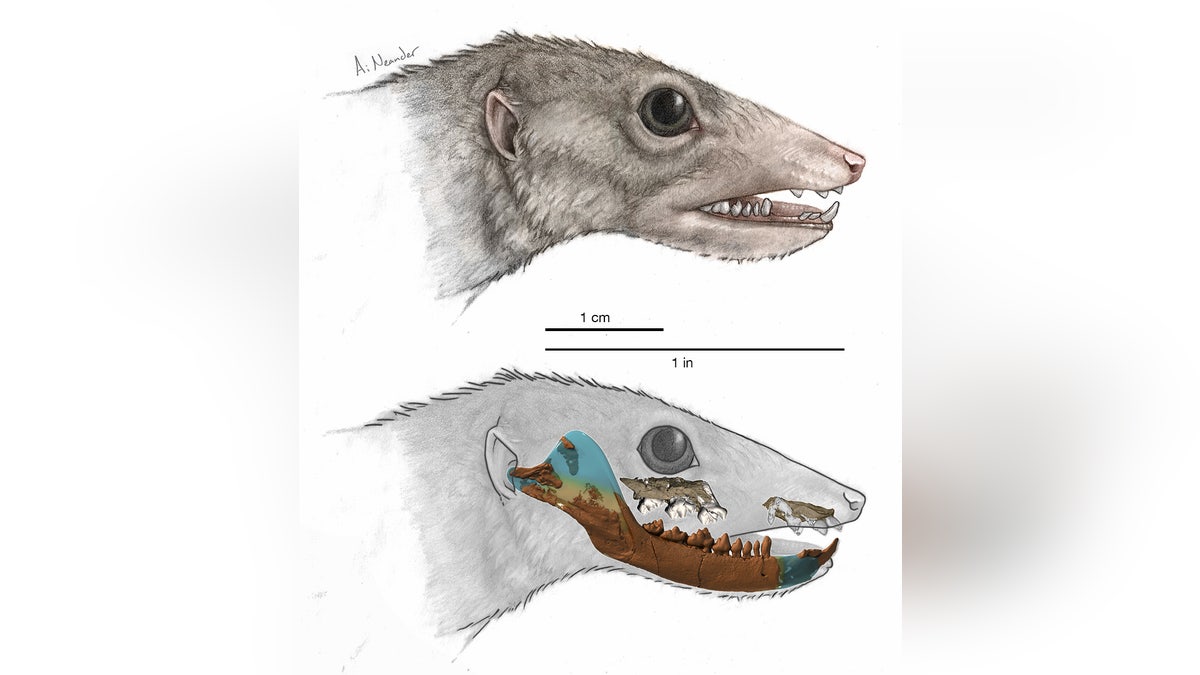
An illustration of Haramiyavia, the earliest known proto-mammal, whose identity is based on a reconstruction of its 210-million-year-old fossil jaw (superimposed on bottom illustration). (April Neander)
Three-dimensional computer models of fossils from a tiny mouse-size creature that lived about 210 million years ago in what is now Greenland clear up a long-standing mammal mystery.
The high-tech analysis of the fossils suggests that mammals originated more than 30 million years more recently than previously suggested, the researchers say.
Paleontologists analyzed fossils of haramiyids, extinct relatives of modern mammals that lived about 210 million years ago. For decades, researchers only had isolated teeth from haramiyids, stymying investigations into where these creatures fit on the mammalian family tree. [See Images of 2 Tiny Early Mammals from China]
This uncertainty about where haramiyids belonged raised two possibilities. One was that haramiyids were crown mammals — the branch of the mammal family tree that all modern mammals descend from — suggesting that mammals began to diversify more than 210 million years ago in the Triassic Period. The other was that haramiyids occupied a separate branch at the base of the mammal family tree, suggesting instead that mammalian diversification began about 175 million years ago in the Jurassic Period.
To help solve this mystery, scientists analyzed a remarkably well-preserved jaw from a haramiyid species known as Haramiyavia clemmenseni, discovered in Greenland in 1995.
"These fossils are extremely rare," study lead author Zhe-Xi Luo, a paleontologist at the University of Chicago, told Live Science. "You have to go into the Arctic tundra and search for tiny little bits of fossils."
The paleontologists theorized that Haramiyavia was a small creature, weighing from 50 to 70 grams, or about twice as much as an adult mouse.
"As the earliest known haramiyid, Haramiyavia is the key piece of evidence for inferences about the timeline of early mammalian evolution," Luo said in a statement.
The researchers used high-resolution computed tomography (CT) scans to develop 3D computer models of the jaw that helped them investigate this specimen in unprecedented detail.
"With the CT scans, we were able to see every little piece of this fossil," Luo said.
This high-tech analysis revealed many primitive structures in the haramiyid jaw, including a trough in the back of the jaw that would have been connected to a primitive middle ear, and a bony prominence on the hinge of the jawbone. These two features provide strong evidence that haramiyids are more primitive than true mammals. This theory is supported by the lack of these two jaw features in the multituberculates, a group of early mammals that prior research suggested was closely related to the haramiyids.
"This was clearly a dead branch of the mammal family tree, going off to the side," Luo said, referring to the haramiyids.
The scientists also created virtual animations that showed how Haramiyavia teeth functioned. Their research showed that haramiyids possessed incisors for cutting and complex cheek teeth for grinding plant food, suggesting that they were omnivores or herbivores. In contrast, other early proto-mammalian groups had less complex teeth, which were adapted for eating insects or worms.
"They broke away from being insectivores and carnivores and invaded an herbivorous-eating niche, opening up a whole new world for themselves," Luo said.
Plant-eating mammals did later evolve complex teeth similar to those of haramiyids, despite the fact that they were not direct descendants of haramiyids. This is a striking example of convergent evolution, a bit like how flapping wings evolved from arms in birds, pterosaurs and bats.
"This herbivory adaptation evolved many times," Luo said.
Many questions remain about how haramiyids lived. "Now that we know their address on the evolutionary tree, we want to better understand how they went about their daily lives — for instance, we'd like to know how they moved about," Luo said.
The scientists detailed their findings online Nov. 16 in the journal Proceedings of the National Academy of Sciences.
- In Photos: Mammals Through Time
- Image Gallery: Evolution's Most Extreme Mammals
- Photos: Earth's Most Ancient Organisms
Copyright 2015 LiveScience, a Purch company. All rights reserved. This material may not be published, broadcast, rewritten or redistributed.
